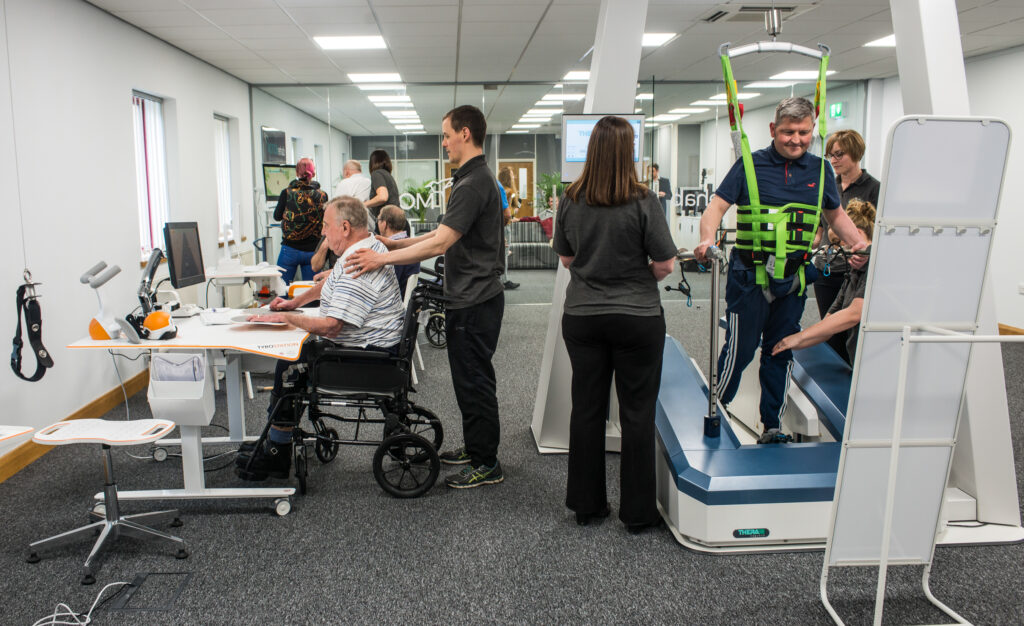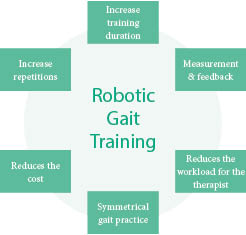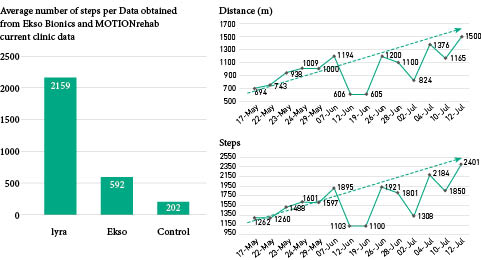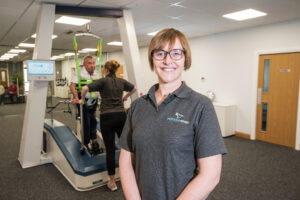
Science
Intensive Gait Rehabilitation
Sarah Daniel has challenged the perception of “traditional” rehabilitation with the implementation of technology and an evidence-based approach to intensive and high repetition training. In this expert interview, she shares her experience of using electromechanical assisted gait training and explains the advantages it has over conventional methods.
Question:
Sarah, thank you for sharing your experiences of using rehabilitation technology to help patients to recover from neurological disease. What prompted you to rethink outpatient rehabilitation in the UK and to start to integrate robotics as an integral part of what you do at MOTION Rehab?
Sarah Daniel:
With the constant developments in acute medical care, there is a growing population of individuals living with disabilities after neurological injuries or disease. Patients are surviving longer and living with greater disabilities. Consequently, rehabilitation services are in demand, staffing resources are significantly under pressure here in the UK and I‘m sure that‘s extrapolated across the globe.
Traditional approaches, of ‘hands-on’ therapy have high staffing requirements but low repetition and intensity. For example, if someone with a complex disability wants to learn to walk again, it may take between two to four clinicians (1) to enable them to take a few steps which is not sufficient to influence neuroplasticity, the re-wiring of the nervous system.
In addition, it is not uncommon for rehabilitation to be time limited which further impacts on the ability for patients to achieve the high repetition and intensity required to maximise therapy outcomes and reach their potential. After reflecting on the research literature and evidence base, I concluded traditional models of rehabilitation alone seemed inadequate and decided to re-think my clinical practice.
In 2017 during the conception of the clinic, I took inspiration from the Team at UCL London who had introduced an intensive upper limb programme, as well as visiting clinics across Europe who had already started to integrate Robotics and Rehabilitation Technologies into their clinical practice. The combination of these experiences resulted in the development of the MOTIONrehab concept which combines highly skilled ‘hands-on’ therapy with robotics and rehabilitation technologies.
“We see a growing population of individuals with disabilities after neurological insult.”
Question:
You decided to use the THERA-Trainer lyra end effector gait trainer in your centre. What advantages does the device offer?
Sarah Daniel:
The Lyra is an effective and efficient rehabilitation device for gait (walking) training. The LYRA provides body weight support which opens up the possibility of walking therapy for those people who are currently unable to walk or find walking difficult and can provide intensive training in a safe and effective environment.
The individual’s feet held in place on mobile footplates driven by the robotic technology. The movement of the footplates replicates a natural walking pattern so that the patient can achieve high repetition of steps in a highly reproducible and consistent walking pattern.
By implementing the Lyra in our clinic, our patients can significantly increase the number of steps and the distance walked to provide controlled cardiovascular training and strengthening of muscles needed to improve their walking ability.

Question:
How was the Lyra received by your therapists?
Sarah Daniel:
Rehabilitating an individual’s ability to walk is complex. Patients need to be supported to stand up against gravity and step from one leg to the other, which can be challenging when there is muscle weakness , loss of balance or other impairments caused by neurological injury/disease. Consequently, walking rehabilitation can be physically very demanding for clinicians as well as the patient.
The implementation of the Lyra Robotic Gait Trainer has reduced the physical burden on the clinical staff, as well as reducing the number of staff required to support the patient.
It is our experience that the body weight support system allows even patients with significant disabilities to get up and walking. The Lyra is quick and efficient to transfer into, generally only requiring the assistance of one staff member, so the patient can start training right away.

“There is consistent evidence that increased frequency and intensity of gait therapy can improve recovery rates and outcomes.”
The design of the Lyra allows the MOTIOnrehab staff to facilitate movements to ensure the best possible walking patterns are achieved. The clinician are also able to measure speed, number of steps and distance walked, this helps with goal planning and tailoring treatment plans to the patient’s individual needs. All the staff agree that the Lyra provides more efficient and effective therapy resulting in better outcomes for the patient.
“20% more patients are being able to walk compared to traditional therapy approaches.”
Question:
Does the scientific literature support the therapeutic approach you describe?
Sarah Daniel:
There is high quality research evidence indicating that patients who receive electromechanical-assisted gait training, such as training on the Lyra, in combination with physiotherapy after stroke are more likely to achieve independent walking than people who receive gait training without these devices.
Research also shows improvements in walking speed and capacity if patients use a robotic gait trainer as part of their rehabilitation. Furthermore, studies have demonstrated improvements in global motor performances, walking endurance, balance and coordination, lower limb strength and even spasticity. Crucially, patients who have access to robotic gait training can achieve up to 20 times more repetitions during a therapy session, with some research indicating that as many as 20% more patients can walk independently when they have access to this therapy. However, the optimum amount of robotic gait training with regards to frequency, duration & timing of the therapy remains unclear. MOTIONrehab continue to support and work our colleagues in research and academia where possible to help contribute to the knowledge base.

Question:
What is your experience of using the Lyra look like in your practice?
Sarah Daniel:
The implementation of the Lyra within the MOTIONrehab clinic has achieved some really positive outcomes for our patients. Firstly, the patients express that they really enjoy the sessions and are highly motivated to train on the Lyra. For some of our patients it is their first opportunity to walk since the onset of their disability. It can be very emotional for the patient, family members and even staff. Research data indicates that patients in traditional therapy only achieve on avaerage 202 steps per session (1). If exoskeletons are implemented in gait training, the data suggests the average number of steps increases to 592 (2). We were therefore keen to assess the impact the Lyra had on repetitions of steps for our patients. A basic audit of the patients using the Lyra in the first year we were operational demonstrated the average number of steps was 2159, more than 10 times the number of steps compared to traditional therapy. One case study patient also demonstrated that over an 8-week period they were able to walk twice as far at the end of their therapy intervention compared to what they could achieve at the start of their treatment programme with MOTIONrehab. I am pleased to report this is not an isolated case! Our clinical data indicates patients are getting better quicker! Feedback from family and friends indicates that this is translating into being able to return to everyday activities such as work, hobbies and socialising. For the team at MOTIONrehab this is really positive because helping people to be able to return to the things they enjoy doing is the essence of rehabilitation.
THERAPY-Magazin:
Thank you Sarah, for this brief introduction and experience snapshot.
References:
1. Efficacy of an exoskeleton-based physical therapy program for non-ambulatory patients during subacute stroke rehabilitation: a randomized controlled trial Louie DR, Mortenson WB, Durocher M, Schneeberg A, Teasell R, Yao J, Eng JJ of the Rehabilitation Research Program, Vancouver, Canada. Published in J. Neuroeng Rehabil. 2021 Oct 10. 18(1):149. doi: 10.1186/s12984-021-00942-z
2. Tyson SF, Woodward-Nutt K, Plant S. How are balance and mobility problems after stroke treated in England? An observational study of the content, dose and context of physiotherapy. Clin Rehabil. 2018 Aug;32(8):1145-1152. doi: 10.1177/0269215518777789. Epub 2018 Jun 1. PMID: 29852758. Jun 1. PMID: 29852758.
Sarah Daniel
is the Owner and Founder of MOTIONrehab Limited. In 2018 Sarah opened the UK’s first Intensive Robotic-Led Neurological Rehabilitation Centre. The unique innovation has challenged the perception of ‘traditional’ rehabilitation with the implementation of technology and an evidence-based approach to intensive and high repetition training. Her forward thinking, industry disruption and innovation has resulted in global invitations to speak at industry conferences, consult on clinic development worldwide and an international award.
Due to clinical demand Sarah opened a second facility, based in Hull in December 2020. Both clinics have international reference centre status for treatment, training, and research. In this expert interview, she shares her experience of using electromechanical assisted gait training and explains the advantages it has over conventional methods.
Related contents
Find related exciting contents in our media library.
Meet our specialists.
Are you interested in our solutions? Schedule a meeting with a Consultant to talk through your strategy and understand how TEHRA-Trainer can help you to advance rehabilitation.